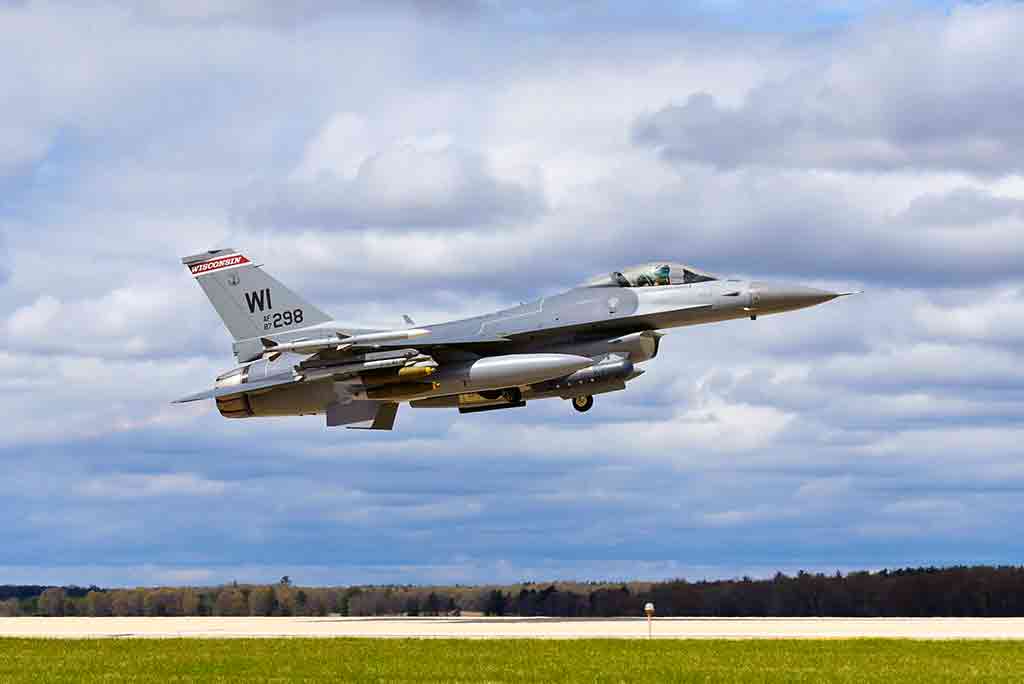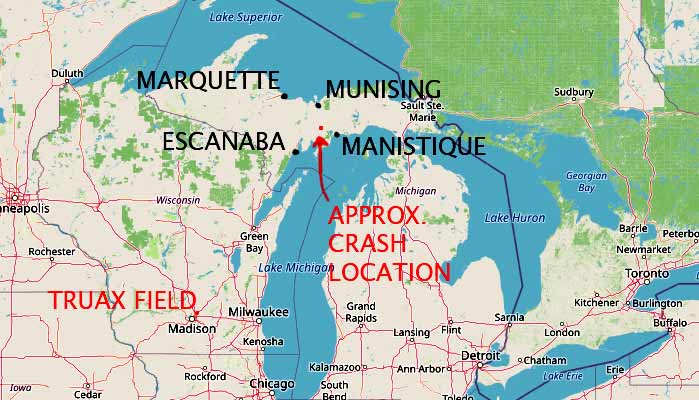A Wisconsin Air National Guard fighter jet crashed in a sparsely populated, heavily wooded area of Michigan’s Upper Peninsula around 8 p.m. on the night of Tuesday, December 8. The pilot was considered missing until Thursday afternoon, and a massive search was under way by the U.S. Coast Guard, local emergency responders, military personnel, and others, according to multiple sources. Sadly, the pilot has been declared dead late Thursday afternoon.
The F-16 Fighting Falcon aircraft belonged to the 115 Fighter Wing stationed at Madison, Truax Field.

The F-16 Fighting Falcon aircraft from the 115th Air National Guard based in Madison, Wisconsin (Source: 115th Fighter Wing)
Truax Field is a civilian-military airport located 6 miles (9.6 km) northeast of downtown Madison, the Wisconsin state capital, also known as Dane County Regional Airport (IATA: MSN, ICAO: KMSN). The plane crashed in the National Hiawatha Forest, approximately 300 miles (483 km) North-East of the base, during a routine training mission. The Wing posted an update on Facebook around 4 p.m. on Thursday afternoon declaring the pilot dead. The post said:
The Wisconsin Air National Guard’s 115th Fighter Wing announced today the death of an F-16 pilot who crashed in Michigan’s Upper Peninsula Dec. 8.
Capt. Durwood “Hawk” Jones, 37, of Albuquerque, New Mexico was identified on Friday as the pilot who lost his life in the accident. According to the Facebook post by the 115th Fighter Wing:
Capt. Jones joined the Air National Guard in 2011 and graduated from F-16 basic qualification training in 2015. He is a decorated combat veteran, deploying as a part of a United States Pacific Command Theater Support Package to Japan in 2015 and to Korea in 2017. He deployed again in support of Operation Freedom’s Sentinel to Afghanistan in 2019. Capt. Jones has been awarded two Air Medal’s with combat “C” devices, which are awarded to individuals who have been personally exposed to hostile action.
"We are deeply saddened by this tragic loss; our thoughts and prayers are with the family during this difficult time," 115th Fighter Wing commander Col. Bart Van Roo said on Wednesday. "Today is a day for mourning, the 115th Fighter Wing and the entire Wisconsin National Guard stands with the pilot’s family as we grieve the loss of a great Airman, and patriot."
In 2011, another pilot from the 115th Fighter Wing taking off from Volk Field and flying the same kind of aircraft survived after ejecting over Adams County, Wisconsin, during a similar routine training mission.
This time, the aircraft crashed near Gooseneck Lake inside the Hiawatha National Forest. The closest community to the crash site seems to be the small village of Steuben, located in adjacent Schoolcraft County. The Hiawatha National Forest spans the Upper Peninsula of Michigan between Escanaba and Manistique in the South, and Munising, on the shore of Lake Superior in the North. It is a very sparsely populated area of wilderness, marshes, dense foliage, few roadways, and wild animals, including potentially dangerous bear and moose.

Approximate crash location inside Hiawatha National Forest.
(Map source: OpenStreetMaps.org, author's annotations)
I used to live in Munising and personally know this area very well, specifically including from the air. This is the part of the country where I earned my own wings some twenty-two years ago, taking off from the, now defunct, Marquette County Airport at Marquette, later relocated to the former K.I. Sawyer Air Force base in Gwynn, Michigan, just South of Marquette. Flying over the Upper Peninsula in small general aviation airplanes, I have often wondered what I would do if I were ever forced to land off-airport. There are very few places that look enticing from the air there. It is really a very remote area, which undoubtedly made it more difficult for the rescuers.
Captain Jones presumably wasn't attempting to land. The nearest airports available in the area are Sawyer International (Marquette County), Escanaba (Delta County), and Manistique (Schoolcraft County). The crash site appears to be somewhere in the middle between Manistique and Munising. Very picturesque area, but quite inhospitable and remote.
Initially, the hope was that the pilot of the F-16 ejected before the crash and parachuted to safety. He would then have to have landed, likely, on top of a dense forest canopy, at night, which may be a complicating factor and may have contributed to his demise. This is pure speculation on my part at this point, just knowing the area and its characteristics. No information is available as to the cause of the crash or the circumstances of the pilot's death. It’s not known if the pilot died in the crash, or was able to eject from the plane before the accident.
According to their Facebook page, the 115th Fighter Wing conducted evening training missions this week, as they do more or less every month, during which the planes took off and landed as late as 10 p.m. I don't like flying at night myself, because I cannot see where to emergency land, if necessary. The area of the Upper Michigan Peninsula appears to the pilot at night as a pitch-black expanse, with no specific detail, punctuated with only individual lights here and there. Not very promising in the event of a forced landing or - as in the case of the F-16 pilot - a possible parachute jump.
Many people have expressed their concern for the pilot, including Wisconsin governor Tony Evers, who said Wednesday he was "devastated" to learn of the crash. Many people were hoping for the safe return of the pilot, but with the latest update, all of that hope is lost. In the words of the Wing Commander, Col. Roo:
“We are an extremely close knit group at the fighter wing, the loss of one of our own brings immeasurable sadness to every member of our organization.”
Not only to the members of the Fighter Wing, we may add, but to all those who appreciate the efforts of the Air National Guard airmen and ground crews. May their pilot rest in peace. We extend our condolences to his family and to his 115th Wing comrades.
Andrew is a lifelong aviation enthusiast, a licensed and instrument-rated private pilot and an airplane owner, with keen interest in aviation business, technology, and its history.



